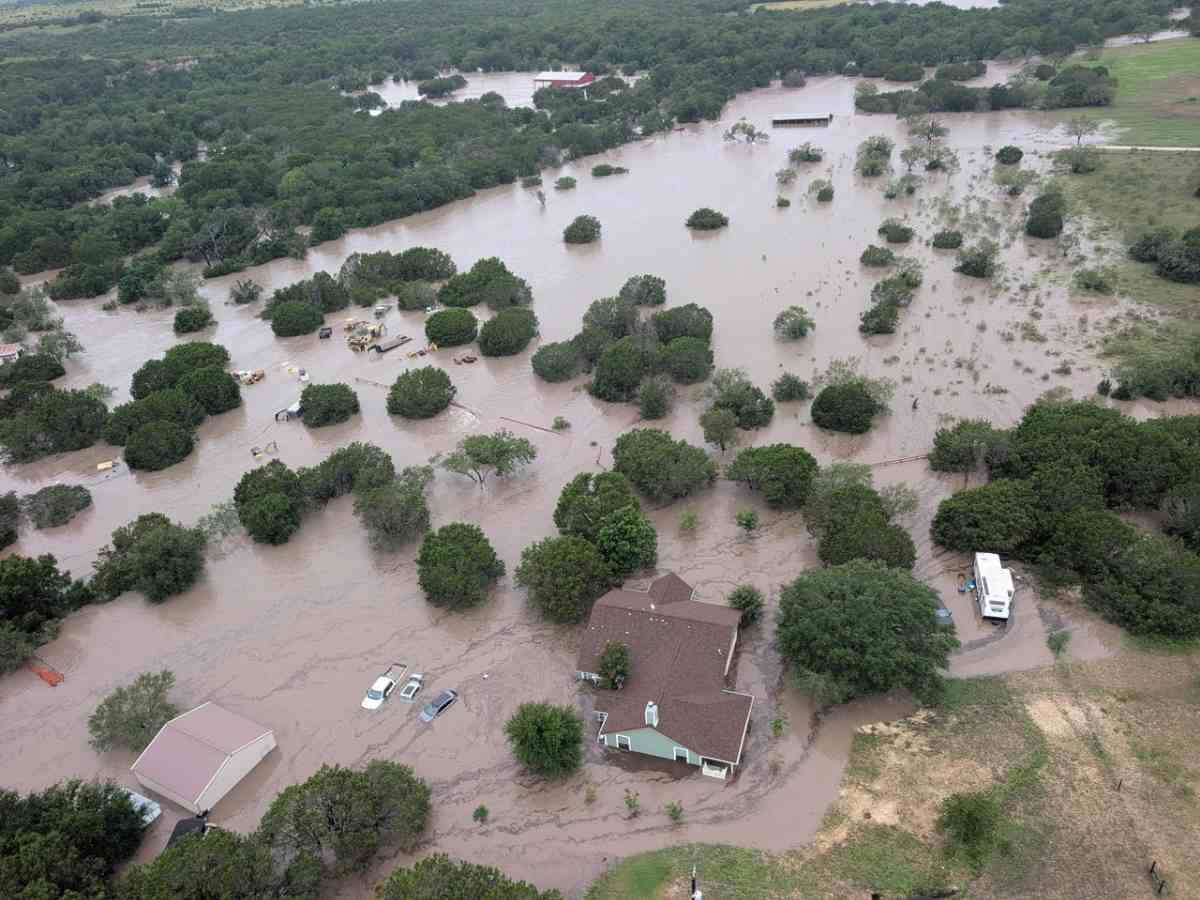(Updated July 17, 2025) The Fourth of July weekend in 2025 painted a picture of unimaginable terror across Central Texas. What began as an ordinary summer night for many quickly transformed into a struggle for survival as torrential rains ignited a series of flash floods. The Guadalupe River swelled with a ferocity that few had ever witnessed, sweeping away homes, vehicles, and, most tragically, lives. As the communities of “Flash Flood Alley” grapple with the immediate aftermath, the question echoes: how does the July 2025 flood compare to the state’s history of floods?
The July 2025 Central Texas Floods
From July 4th through the 7th, Central Texas bore the brunt of a powerful weather system intensified by the remnants of Tropical Storm Barry. This unleashed an extraordinary amount of water in a short time. In the hardest-hit areas of Kerr County, rain gauges overflowed, recording anywhere from 5 to 11 inches, with some localized pockets receiving a staggering 20.33 inches of rainfall.
The sheer intensity transformed waterways into raging torrents. The Guadalupe River near Kerrville surged 26 feet in just 45 minutes. Upstream in Hunt, the river crested at 37.5 feet, a level not seen since at least 1966.
The floodwaters carved a path of devastation through the Hill Country. Homes and cabins along the river were ripped from their foundations and carried downstream. RVs were twisted wrecks, and cars lay submerged. The riverbanks became choked with a grim testament to the flood’s power: twisted trees, mangled mattresses, and the remnants of shattered lives.
Yet, beyond the material destruction, the human cost of this disaster is truly heartbreaking. As search and rescue teams tirelessly comb through the debris, the confirmed death toll has climbed to approximately 134 individuals, with dozens more still reported missing. Kerr County alone accounts for at least 106 of these fatalities, including 36 children. Travis County has confirmed 8 deaths, with additional fatalities across Williamson, Burnet, Kendall, Tom Green counties. Camp Mystic, an all-girls Christian summer camp in Hunt, became a scene of unimaginable sorrow as at least 27 campers and counselors lost their lives. Approximately 101 individuals remain unaccounted for, with most in Kerr County.
The suddenness of the flood, often described by traumatized survivors as a “pitch black wall of death,” left little time for escape, particularly for those caught unawares in the early morning hours.
Placing the July 2025 Texas Flood in Historical Context
Texas has a long, tumultuous relationship with water. Its varied terrain and susceptibility to both tropical systems and intense thunderstorms mean that floods are a recurring, often devastating, chapter in its history. While the impact of the July 2025 floods feels uniquely horrific, a glance at the state’s lineage of watery disasters.
Here’s how this tragedy compares to some of the most significant and deadliest Texas floods:
- The Galveston Hurricane (September 8, 1900): This catastrophic event, while primarily a storm surge, remains the deadliest natural disaster in U.S. history. An estimated 8,000 to 12,000 lives were lost as the island city of Galveston was utterly obliterated by the sea. The 1900 hurricane stands as a benchmark for human loss in Texas, a scale of tragedy unmatched by any single flood event since.
- The Great Flood of 1921 (San Antonio / Thrall Flood – September 1921): Unleashing an astonishing 39.7 inches of rain in just 36 hours in Thrall, this inland deluge led to 224 recorded deaths, with San Antonio bearing the brunt of the tragedy. The 1921 flood demonstrates a rainfall intensity and death toll that still exceeds the current 2025 event, making it the deadliest inland flood in Texas history.
- The July 2025 Central Texas Floods (July 4-7, 2025): With over 134 confirmed deaths and counting, and extreme localized rainfall up to 20.33 inches, this event is already cementing its place as one of the deadliest inland flash flood disasters in Texas history. The rapidity of the river’s rise—26 feet in 45 minutes—is a terrifying hallmark, setting it apart from more prolonged rainfall events. Damage caused is estimated to be approximately $18-$22 Billion. The specific tragic loss of life at summer camps adds a particularly poignant dimension to this disaster.
- Hurricane Ike (September 2008): This powerful hurricane brought a devastating 20-foot storm surge to Galveston and widespread flooding across Southeast Texas. Ike was directly or indirectly responsible for over 100 deaths and inflicted an estimated $29 billion in damage. While its nature was different (coastal hurricane), its overall human toll aligns sadly close to the current inland flood.
- Hurricane Harvey (August 2017): Landfalling as a Category 4 hurricane, Harvey became synonymous with unprecedented rainfall, dumping “several feet”—up to 60 inches in some areas—over a prolonged period. This led to immense freshwater flooding across Houston and the Gulf Coast, causing at least 68 deaths and an estimated $125 billion in damage, making it one of the costliest natural disasters in U.S. history. While Harvey’s scale of damage and widespread impact were far greater, the July 2025 event demonstrates a horrifyingly high fatality rate for a localized flash flood.
- Tropical Storm Allison (June 2001): Allison, a persistent and slow-moving storm, unleashed 40 inches of rain in parts of Texas, primarily inundating Houston. It led to 41 deaths in Texas, mostly due to flooding, and caused over $5.2 billion in damage. Unlike the rapid flash flood of 2025, Allison’s devastation came from prolonged, heavy urban rainfall.
- October 1998 Central Texas Floods (October 17-19, 1998): This event, also striking the Hill Country, saw 20-30 inches of rain and claimed between 25 and 31 lives, with over $500 million in damage. It underscores the recurring vulnerability of this specific region, but the current 2025 flood has tragically surpassed its fatality count.
- May 1972 South Central Texas Floods: Torrential rains caused major flooding, resulting in 18 deaths, primarily in New Braunfels and McQueeny.
- May 2015 Blanco River Flood (Memorial Day Weekend, May 2015): Another devastating flash flood in the Hill Country, where the Blanco River crested near 50 feet—rising 5 feet every 15 minutes. This event claimed 13 lives and destroyed nearly 400 homes.
- July 1987 Flood (Central Texas – July 17, 1987): This flash flood tragically claimed 10 lives, all students on a school bus heading to a church camp, after 11.5 inches of rain fell near the Guadalupe headwaters.
A Recurring Challenge in Flash Flood Alley
The July 2025 Central Texas floods serve as a painful reminder of the dangers within “Flash Flood Alley.” This region’s unique geology—steep hills, thin soil, and limestone formations—causes rainwater to race across the surface rather than being absorbed, funneling it rapidly into rivers and creeks with devastating speed. The high death toll from this event places it among Texas’s most tragic flood chapters.




